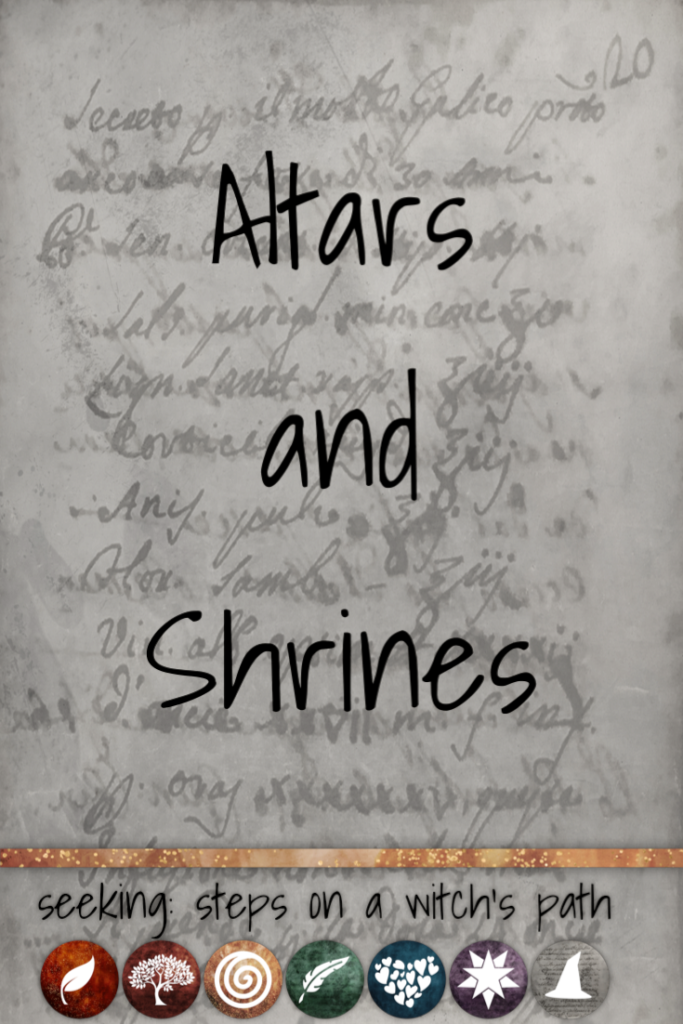What’s an altar? How is it different from a shrine? If you’re confused by these and other questions, you’re definitely not alone. Here’s some help in sorting out the differences and what might be helpful practices.

Some working definitions:
Many people get confused about the difference between altars and shrines.
An altar is a ritual tool that holds other tools, and that helps you direct and anchor the energy of your working. That’s why so many altars are made either of wood or of stone – both materials make it particularly easy to turn the altar into an anchor for all the other energy work of the ritual.
Many religions use an altar as a central focus for worship and ritual – in part because it’s very practical. It gives you a place to put all the other stuff you use in ritual, so it’s right at hand.
A shrine is a place where we honour a particular deity, spirit, or other entity. They’re common in a wide range of religions too – you can see fabulous Buddhist and Hindu shrines throughout Asia, many Catholic shrines to saints, and there are many other historical examples.
So, a given physical space can be an altar, a shrine, or both, depending on what you’re doing. What does that mean in practice?
Altar:
When?
Many people choose to set up an altar only for the time they’re going to be working ritual. Otherwise, they pack the ritual tools away.
This is also a very practical choice for people who don’t have a lot of space, who have small children (who may try and grab sharp, pointy, or breakable things without asking), or who may have people visiting who aren’t comfortable with a Pagan altar.
Where?
Some traditions put them in the north (mine does). Some put them in the center. Some put them in other directions. If you’re casting a circle and the altar is at one of the edges of the circle, you can either walk around it (if space allows, like if you’re outside), or you can simply direct the energy flow to include it.
What?
Ideally, an altar should be something solid and made of natural materials (as you hope for other ritual tools…) However, if what you’ve got is highly processed pressed board, or a card table… well, make that work. You can set up an altar on a trunk, a box covered with an altar cloth, or any other flat surface.
I do recommend making it standing height (if you’re going to be standing up) or at least knee height (if you’ll be sitting in front of it). You don’t constantly want to be bent over to handle things on the altar and altars on the floor can risk candles falling or being knocked over.
What tools?
Again, this depends on the tradition. Common things to include are:
- an altar cloth in an appropriate color for the ritual’s focus (seasonal colors, a color for the working you’re doing, like green for prosperity working.) You don’t absolutely need one, but it’s much easier than scraping candle wax off a table.
- candles for God, Goddess, and other uses.
- whatever tools you’re going to use (athame, chalice, pentacle, wand, incense, salt, water, etc.)
- whatever you need for the working (herbs, yarn, whatever)
What else?
You might also include flowers or seasonal greenery, living plants, crystals, representations of the elements, divination tools, and much more. (There’ll be photos here shortly of several examples.)
How do you arrange your tools?
This will depend a lot on your specific tradition or path. Different paths and traditions put the altar in different locations (some in the north, some in the east, some in the south or west, some in the center.) They may arrange their tools differently from others, or the layout may change with the time of year, the kind of working, or other factors.
You can see an example of a basic altar setup for my personal work (in the mode of the tradition I’m trained in) in the photograph below. It’s described in more detail on another page on the site.
My tradition places items relating to Goddess and the elements of earth and water on the left of the altar as you stand at it, and items relating to God, air, and fire, to the right. This is set up on a fairly narrow bookshelf (about 1 foot by 3 feet). You can read a complete description on a page elsewhere on the site that has more about these specific tools.
Shrine:
In contrast, a shrine is often a lot more free-form. It includes whatever you want it to include. (Or maybe, whatever the deities you’re honoring want you to include.) However, many of these things may not look obviously Pagan. This can be very handy if you’re living with other people, or in a dorm, or some other situation where you’d like privacy about your religious practice.
You might include:
- A candle for meditation (if a real candle is a problem, consider an LED one or a bowl of water or some other item that serves as a focal point.)
- A representation of each element. If you want some ideas, you can try these…
- Air: A feather, pale pastel ribbons, a pen, small carved statues of birds
- Fire: A candle, glass hearts or stars, volcanic rocks, other hearts or related symbols.
- Water: A bowl of fresh water (refill it daily, ideally), shells, sanddollars, etc.
- Earth: A small living plant, tumbled or river-smoothed rocks, a bowl of salt or dirt.
- Images or statues of a particular deity or story or other thing you’re honoring. Tarot or oracle cards can be a great way to find images to focus a shrine.
- Any jewelry or other items you’re currently focusing on in daily workings. For example, if you’re charging a glass of water with your purpose and drinking it, you’d want a cup. If you choose to wear a necklace with a particular symbol, it could live on your shrine when you’re not wearing it.
- Incense, scented oil, or other things of that kind to use for a daily blessing or annointing ritual. (You can also use water that’s been blessed with a particular energy.)
Here is an example of my shrine as it is at the moment (January 2017)
This is the main ritual center in my home, and you can see items mostly focused on ongoing or daily practice work here. More information about the items available elsewhere on the site.
Other notes:
Some people change their shrines or home altars for every season. I am not one of them – I don’t usually use an altar cloth on my shrine. While I might add some seasonal plants (greens in winter, flowers in summer), there are long stretches where I don’t do that.
What you do need to do, however, is dust. Make sure you use things. If you’re not using things, consider whether you still need them there. A simple altar or shrine is fine. No altar or shrine is fine. A neglected one, however, is not so good.
Remember that both altars and shrines are tools. They’re meant to help you, not lurk in the corner making you feel guilty.
That’s why I keep my shrine fairly simple: it’s a visual focus of the things I’m working on, that I see lots of times every day (it’s in my front room, on the bath between my bedroom area on one side, and the kitchen and bathroom on the other, so as you can imagine, I go by it a lot.)
There are days I spend a bunch of time there, and days when mostly what I do is go past, smile at it, and maybe touch one of the statues to focus a particular energy.
Finally, when considering location – if you have it in a public space, people may put things on it. Soda cans, keys, whatever. If you don’t want them to do this, you’ll need to either explain to them not to do that. (You don’t need to say “That’s my shrine” if you’d rather not. “Hey, that’s where I keep some special things. Could you put your can over on that shelf?” works too.)
Or you can design a shrine or altar that doesn’t have much visible clear space, which can help.

Last edited January 1, 2017. Reformatted November 2020.






Pingback: Differenes Explored, Part I: Shrines and Altars | Thracian Exodus
Pingback: Differences Explored, Part I: Shrines and Altars | Thracian Exodus
Pingback: Altars Vs Shrines | Wings of the Firebird
Pingback: Altars vs Shrines | Song of the Firebird
Pingback: Cycling the Granite way, Summer Solstice Garden | Mostly Outdoors
Pingback: Altars Vs. Shrines | A Glorious Beauty